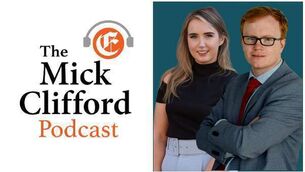When Roses fade, what next for Tralee?

Does the suggestion — made in a witty Tweet — strike terror into your soul? Possibly, yet you have to wonder why, year on year, the Rose Selection Live strikes TV ratings gold. A mind-blowing 1.7m people tuned into the show this week, making it one of the highest-ranked programmes of the year.
Could Dáithí and the cailíní deasa actually be the most successful reality TV show on earth?
It certainly has all the ingredients: ordinary people made (sort of) famous; moments of ritual humiliation; the occasional revelation; lasting appeal; swathes of deathly dull programming and, finally, the dangling carrot of the winner’s crown.
As a native of Tralee — and a secret fan of kitsch — I still don’t quite get it, but I’m hugely grateful that fellow townspeople had the idea of reviving Tralee’s Carnival Queen in 1959 and fashioning it into an international festival based on the 19th-century love song ‘The Rose of Tralee’ by William Mulchinock.
That it has survived down through the years is testament to the hard work and business nous of the organisers who have succeeded in reinventing it with each passing decade. Now, it is less about showcasing “the lovely girls” but celebrating the strong women of the diaspora and promoting equality.

It was something of a coup when 2014’s winner Marie Walsh spoke openly about being gay and her hopes of being married one day. Her words captured the mood of the moment, prefiguring this year’s same-sex marriage referendum.
That degree of prescience has to be accidental but the happy coincidence must have helped keep viewer numbers high. And it’s a high that’s catching. Thanks to the organisers of the Rose Festival, for one short spell in August, you can fool yourself into thinking that Tralee is a vibrant county town with a future.
Though visitor numbers were slightly down this year, some 90,000 festival-goers pumped €7m into the local economy.
It’s a glorious opportunity to put the words “Tralee” and “bonanza” in the same sentence for a few short weeks. There’s even a slight afterglow when the stages and the festival dome are dismantled and the circus and the amusements trundle out of town.
Then, it’s back to business as usual — or back to no business as usual. In a favourite and well-stocked shop in Tralee centre, I recently overheard a shopper say to the owner: “You have everything in this shop”.
“Yes,” he replied, “everything except customers.”
At least the picture is less bleak than it used to be. There is a slight upturn. The latest unemployment figures show there are 468 fewer people on the live register than this time last year. Yet, there are still close to 6,000 people — that’s nearly one in four — out of work in the town.
Thankfully, that’s not the first thing to strike you if you take a stroll down Denny St, an elegant Georgian street that is packed full of cafés. If a town’s success could be judged on the quality and variety of cappuccinos on offer, then Tralee would be right up there.
There are some small signs of rejuvenation, too, with a few new shops displacing the for let and for sale signs. To this townie at least, those forlorn estate-agent notices bring with them a sense of bereavement.
And there is much to mourn about the demise of Tralee. It’s hard to believe it now, but Tralee was once the industrial capital of Kerry. In the last two decades, it has been stripped of thousands of jobs and several large industrial employers.
The catalogue of closures and job losses is a dismal litany of industrial failure and personal hardship, but it is one that is familiar to rural towns all over the county.
To recap, here are just some of the casualties: In 1983, Kingdom Tubes closed with the loss of 295 jobs. In 1998, Kerry Fashions (220 jobs) and textile company Klopman (200 jobs) closed.
In the last decade, the news continued to be grim. Wilson Socks shut in 2002 (100 jobs). Glen Dimplex shut its Goblin hoover plant in 2006 (76 jobs). 2009 was a dark year: Denny’s meat processing plant, which employed 400 at its peak, finally shut down completely and German multinational Amann closed with the loss of 330 jobs.
Weeds are growing up through Amann’s former site in the Clash Industrial Estate. While the estate is still home to several businesses, it presents a sorry decaying face to passing motorists. That’s a theme in Tralee. Walk around the town and you’ll see abandoned sites where business and industry once thrived.
There have been many more closures, big and small, that have left yawning gaps in the streetscape. The figures show a devastating decline in construction, an implosion in manufacturing and processing and a contraction of the retail and commercial sector.
So what now? The draft Kerry county development plan (2015-2021) identifies the knowledge economy — technology, communications, and research and development — as one of the potential areas of growth.
It also pinpoints the market for so-called green goods as a fast-growing area, along with what it terms the “creative industry” — a combination of technical innovation and artistic creativity.
It’s tempting to think that technical innovation will save us but, even if broadband connectivity was world-class, big companies like to cluster in big cities.

If technology can’t save us, what about the new Rural Affairs Minister Ann Phelan? She certainly seems to understand the issues facing rural Ireland, but can she really implement the findings of the Cedra report, as she has promised to do.
Cedra – a pronounceable acronym that stands for the mouthful, Commission for the Economic Development of Rural Areas — includes a small-town stimulus programme in its recommendations.
But where does that leave biggish Tralee, with its population of more than 23,000? It would certainly have more people if those forced to migrate to bigger centres of population in Ireland could find a way to live and work there.
It might be an idea to ask the organisers of the Rose of Tralee festival if they could take the magic formula that keeps Irish people glued to the TV on Roses night and use it to breathe new life into the town.
And there is so much worth fighting for in Tralee, though I don’t hear too many talking about its lanes and alleys, its canal and windmill, its first-class museum, its dizzying array of coffee shops, the mountains on its doorsteps or the spectacular stretches of beach.
Maybe locals and visitors should start a Facebook page listing what they like about Tralee. If they did, here’s what I’d post:
“Today, on the first day of Heritage Week go to the Town Square in Tralee and look for artist Kate Palmer’s piece; a discreet pair of copper feet surrounded by the rim of a skirt set into the ground. The feet commemorate local woman Judith Brow. She died in 1835 at the age of 110 but worked as a market-square vendor, all year round and without shoes or stockings, until shortly before her death.”
Now there’s a Tralee Rose to remember.















